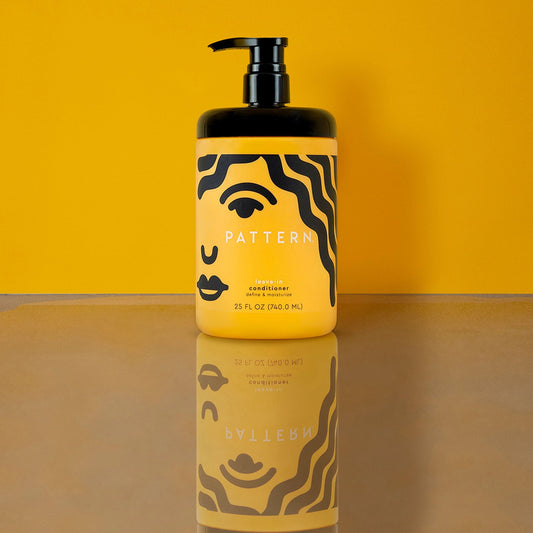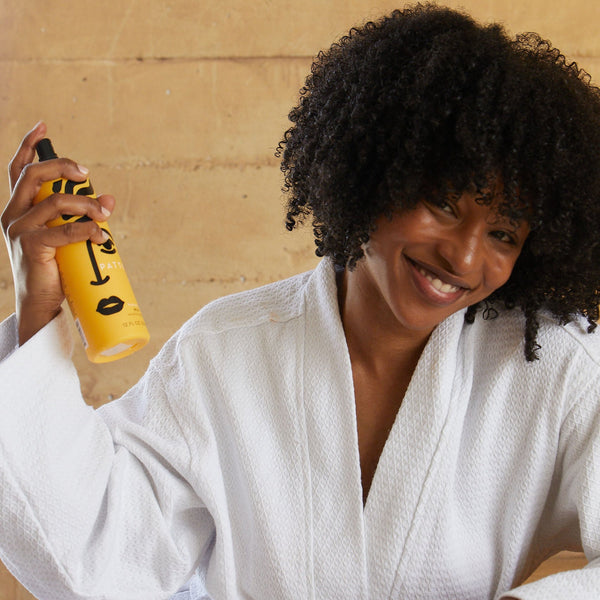When it comes to embracing our beautiful natural hair, it’s important to learn as much as possible, so we can properly care for it and do it with joy. Understanding your hair porosity is an important piece to that puzzle. Low porosity hair is one of the three porosity types. If you have low porosity hair, it’s normal to feel overwhelmed when figuring out what hair care routine, techniques and curly hair products work for you. Low porosity hair just means your hair is lacking moisture because it has a harder time absorbing it. With the right adjustments to your regimen, you will easily be able to care for your low porosity hair. Learn more about your hair porosity type, how to create a wash routine, how to moisturize your hair properly, which products to use, and tips for caring for low porosity hair. Take a dive into the 7 low porosity tips your hair has been waiting for and watch your hair type come to life.
What is low porosity hair?
If you’re here, we’re guessing you know at least a little bit about low porosity hair, but if you’re still figuring out your natural hair, help is on the way. There are three types of hair porosity – low, medium, and high. Hair porosity is your hair's ability to absorb and retain moisture. Compared to medium or high porosity hair, low porosity hair is when the cuticles of your hair are tightly aligned, creating a barrier for moisture to enter. Low porosity hair is water-resistant, so it can be a bit more difficult for this hair type to absorb water and moisture, including hair products. Now that we have an understanding of what low porosity hair is, let’s make sure you can identify your porosity type.
How do I know if I have low porosity hair?
There is a simple hair porosity strand test you can perform with water to see if you have low hair porosity. Take a glass of water and a strand of hair and drop it into the glass. If the hair floats to the top of the glass, you have low porosity hair. Here are some other signs you might notice if you have low porosity hair:
- Products tend to sit on the top of your hair
- You experience buildup more often (from hair products, oil, sweat dirt, etc.)
- Looks or feels oily or greasy
- Your hair feels weighed down
- Your hair takes longer to get fully wet in the shower
- It takes longer for your hair to air dry
How often should I wash low porosity hair?
Generally, low porosity hair is prone to buildup because products sit on the hair, instead of penetrating the hair shaft. This means that if you have low porosity vs high porosity hair, you may need to wash your strands more frequently than someone with medium or high porosity hair. We recommend washing your hair every one to two weeks. Pay attention to your hair and look for signs of buildup like visible residue, flaking, dry or itchy scalp, lack of curl definition and dullness to better learn when it’s time for wash day.
How do you moisturize low porosity hair?
The biggest challenge low porosity hair faces is the ability to take in moisture. Typically, people with low porosity hair think adding more product will give the hair a greater chance at absorbing it, but the key is using the right type of hair care products. Adding more styling product will create buildup and make the hair flaky and feel dry. The use of lightweight low porosity hair products without a lot of oils will penetrate the hair shaft and help absorb moisture better.
7 Low Porosity Hair Tips You Shouldn't Go Without
Since moisture is key to maintaining healthy hair, find out 7 tips on how you can maximize its absorption to get hydrated curls, coils, and kinks.
- Use water-based products
Water-based products are your hair's best friend. Use lightweight formulated products like a milk or spray leave-in conditioner, like PATTERN’s Hydrating Mist. Lighter gels can help prevent buildup. On wash day, use a curl cleansing shampoo to deeply cleanse your scalp and remove impurities, buildup, and excess oil.
- Use a lightweight leave-in conditioner
Moisturizing leave-in conditioner is a staple natural hair care product used to set the hair with moisture and hydration. Low porosity hair needs a lightweight leave-in conditioner that contains humectants (substances that help draw in water and moisture) like, honey, aloe vera, and glycerin to give your hair the hydration it needs. Cream-based leave-in conditioners are too heavy, less likely to penetrate your hair, and can result in product buildup.
- Try a pre-poo treatment
Wash day should be a day of self-care, so why not treat your hair to a pre-poo treatment. Pre-poo or pre-shampoo is a method of applying an oil or deep conditioning treatment before cleansing your hair. This step helps low porosity curly hair to retain its moisture and prevent stripping your hair from the use of shampoo.
- Apply products to damp hair
It’s best to apply products to hair that is wet, but not soaking. When the water has a chance to evaporate, it will allow whatever natural hair styling products you use to set in.
- Wash your hair with warm water
Remember, low porosity hair is when the cuticles of your hair are tightly packed. Using warm water when washing your hair will help to open up the hair cuticle. When the cuticles of your hair open up, your strands will be able to take in the moisture.
- Steam your hair
Hair steaming is a technique used to open up the hair follicles and lift the hair cuticles to allow moisture to penetrate the hair. Add steaming to your hair care routine to allow the benefits of a deep conditioner, an oil treatment, or a mask like PATTERN’s Treatment Mask to hydrate and moisturize your natural curls. Hair steaming also benefits your scalp and helps to remove dead skin cells and buildup that could otherwise impact healthy hair growth.
- Protect your hair at night
Another act of self-care is having a great nighttime routine. In addition to your skincare routine, it’s important to protect your curly hair while you catch up on your well deserved rest. Use a satin cap to prevent the friction that can cause frizz and dryness.
How can I avoid damaging low porosity hair?
Treating your hair gently and using the best products and techniques will help you to care for and avoid damaging low porosity hair. If you have low porosity hair, you should keep the following in mind, to maintain the health of your hair:
- Using heavy oils or butters can accumulate quickly and cause buildup
- Applying too much product or thick, cream-based products cause buildup
- Not washing your hair enough can cause your hair to feel weighed down and dry
- Don’t over do it with protein products and ingredients you use to avoid stiffness and brittleness
- Limit your use of heat tools (like a blow dryer or flat iron)
- Try avoiding over-chemically processing your hair with dyes, relaxers, and perms
Think of having low porosity hair as a chance to treat yourself and your hair to a pre-poo treatment like a hot oil scalp massage. As opposed to using high porosity hair products, taking care of low porosity hair requires using lightweight products to prevent buildup and warm water on wash day to open the cuticles. If you can limit protein treatments, heavy oil products, and heat usage, your hair will be able to absorb moisture better and stay nourished. Invest in a hair steamer or heat cap to allow deeper penetration of hydration in your locks. Most importantly, be patient with yourself and always experiment with different techniques to find what works best for your low porosity hair. Get ready for your hair to thank you in the form of hydrated, juicy, and defined curls and coils!
References:
-
Taylor Davis. "Here's Everything You Need To Know About Hair Steaming". Elle. Nov 13, 2020. https://www.elle.com/beauty/hair/a34632305/best-steamers-for-natural-hair/
- Tembe Denton-Hurst. "The Best Products for High-Porosity and Low-Porosity Hair (and How to Tell If You Have It)". The Strategist. Dec 11, 2020. https://nymag.com/strategist/article/best-products-for-high-low-porosity-hair.html
- Felicia Ler. "Low Porosity Hair: What Is It and How to Tell If You Have It". Function of Beauty, https://www.functionofbeauty.com/blog/lightreads/low-porosity-hair/






